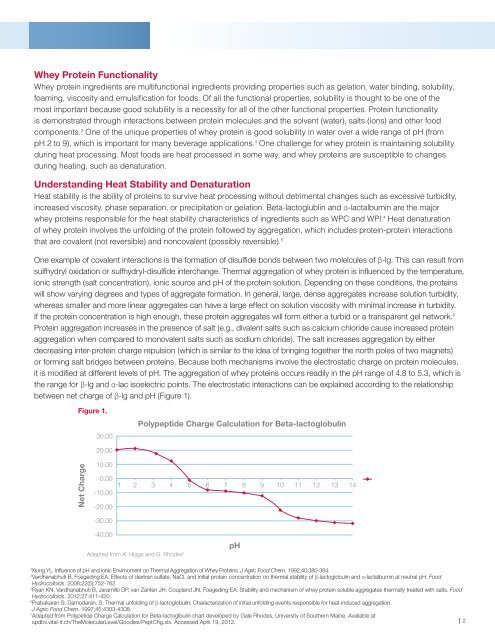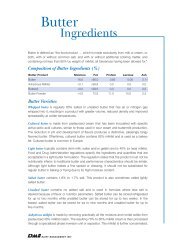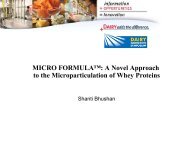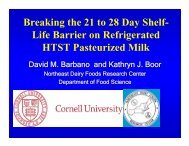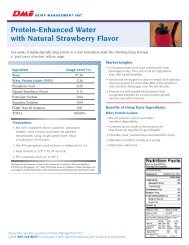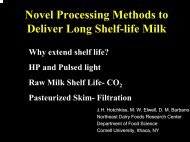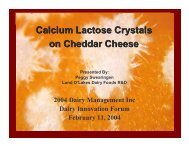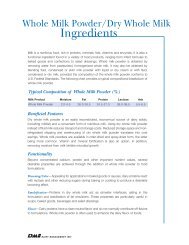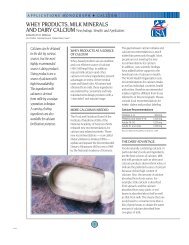Whey Protein Characteristics - InnovateWithDairy.com
Whey Protein Characteristics - InnovateWithDairy.com
Whey Protein Characteristics - InnovateWithDairy.com
You also want an ePaper? Increase the reach of your titles
YUMPU automatically turns print PDFs into web optimized ePapers that Google loves.
Technical Report:<br />
<strong>Whey</strong> <strong>Protein</strong> Heat Stability<br />
<strong>Whey</strong> <strong>Protein</strong> Functionality<br />
<strong>Whey</strong> protein ingredients are multifunctional ingredients providing properties such as gelation, water binding, solubility,<br />
foaming, viscosity and emulsification for foods. Of all the functional properties, solubility is thought to be one of the<br />
most important because good solubility is a necessity for all of the other functional properties. <strong>Protein</strong> functionality<br />
is demonstrated through interactions between protein molecules and the solvent (water), salts (ions) and other food<br />
<strong>com</strong>ponents. 3 One of the unique properties of whey protein is good solubility in water over a wide range of pH (from<br />
pH 2 to 9), which is important for many beverage applications. 4 One challenge for whey protein is maintaining solubility<br />
during heat processing. Most foods are heat processed in some way, and whey proteins are susceptible to changes<br />
during heating, such as denaturation.<br />
Understanding Heat Stability and Denaturation<br />
Heat stability is the ability of proteins to survive heat processing without detrimental changes such as excessive turbidity,<br />
increased viscosity, phase separation, or precipitation or gelation. Beta-lactoglublin and α-lactalbumin are the major<br />
whey proteins responsible for the heat stability characteristics of ingredients such as WPC and WPI. 4 Heat denaturation<br />
of whey protein involves the unfolding of the protein followed by aggregation, which includes protein-protein interactions<br />
that are covalent (not reversible) and noncovalent (possibly reversible). 5<br />
One example of covalent interactions is the formation of disulfide bonds between two molelcules of β-lg. This can result from<br />
sulfhydryl oxidation or sulfhydryl-disulfide interchange. Thermal aggregation of whey protein is influenced by the temperature,<br />
ionic strength (salt concentration), ionic source and pH of the protein solution. Depending on these conditions, the proteins<br />
will show varying degrees and types of aggregate formation. In general, large, dense aggregates increase solution turbidity,<br />
whereas smaller and more linear aggregates can have a large effect on solution viscosity with minimal increase in turbidity.<br />
If the protein concentration is high enough, these protein aggregates will form either a turbid or a transparent gel network. 6<br />
<strong>Protein</strong> aggregation increases in the presence of salt (e.g., divalent salts such as calcium chloride cause increased protein<br />
aggregation when <strong>com</strong>pared to monovalent salts such as sodium chloride). The salt increases aggregation by either<br />
decreasing inter-protein charge repulsion (which is similar to the idea of bringing together the north poles of two magnets)<br />
or forming salt bridges between proteins. Because both mechanisms involve the electrostatic charge on protein molecules,<br />
it is modified at different levels of pH. The aggregation of whey proteins occurs readily in the pH range of 4.8 to 5.3, which is<br />
the range for β-lg and α-lac isoelectric points. The electrostatic interactions can be explained according to the relationship<br />
between net charge of β-lg and pH (Figure 1).<br />
Figure 1.<br />
30.00<br />
Polypeptide Charge Calculation for Beta-lactoglobulin<br />
Net Charge<br />
20.00<br />
10.00<br />
0.00<br />
-10.00<br />
-20.00<br />
-30.00<br />
1 2 3 4 5 6 7 8 9 10 11 12 13 14<br />
-40.00<br />
Adapted from K. Higgs and G. Rhodes 7<br />
pH<br />
3<br />
Xiong YL. Influence of pH and Ionic Envirnoment on Thermal Aggregation of <strong>Whey</strong> <strong>Protein</strong>s. J Agric Food Chem. 1992;40:380-384.<br />
4<br />
Vardhanabhuti B, Foegeding EA. Effects of dextran sulfate, NaCl, and initial protein concentration on thermal stability of β-lactoglobulin and α-lactalbumin at neutral pH. Food<br />
Hydrocolloids. 2008;22(5):752-762.<br />
5<br />
Ryan KN, Vardhanabhuti B, Jaramillo DP, van Zanten JH, Coupland JN, Foegeding EA. Stability and mechanism of whey protein soluble aggregates thermally treated with salts. Food<br />
Hydrocolloids. 2012;27:411-420.<br />
6<br />
Prabakaran S, Damodaran, S. Thermal unfolding of β-lactoglobulin: Characterization of initial unfolding events responsible for heat-induced aggregation.<br />
J Agric Food Chem. 1997;45:4303-4308.<br />
7<br />
Adapted from Polypetide Charge Calculation for Beta-lactoglbulin chart developed by Gale Rhodes, University of Southern Maine. Available at<br />
spdbv.vital-it.ch/TheMolecularLevel/Goodies/PeptChg.xls. Accessed April 19, 2012.<br />
e3.11.1 2


